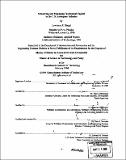Measuring and managing intellectual capital in the U.S. aerospace industry
Author(s)
Siegel, Lawrence R
DownloadFull printable version (13.09Mb)
Other Contributors
Massachusetts Institute of Technology. Dept. of Aeronautics and Astronautics.
Advisor
Eric S. Rebentisch.
Terms of use
Metadata
Show full item recordAbstract
"Intellectual capital" has been heralded in business journals as an important component for successful business development in today's economy. Intellectual capital consists of knowledge-based assets -- including people, relationships, tools, and processes - that create value for a firm and its clients. Previous research has emphasized the financial measurement of intellectual capital, including the valuation of corporate intangible assets and the difference between a firm's market value and book value. Unfortunately, these financial measures are not very useful to practitioners, as they provide few insights about how to allocate resources, improve operations, or strategically plan for future needs. In this research, a new conceptual framework is developed for understanding the role of intellectual capital in new product development. The framework develops a dynamic model of the three forms of intellectual capital - human capital, structural capital, and relational capital -- and identifies mechanisms for knowledge transfer, organizational learning, and value creation. The framework is bolstered by data from case studies of seven product development projects at different U.S. aerospace firms. (cont.) Using the concept of intellectual capital as a "lens", the case studies are comparatively analyzed to identify critical knowledge-based resources and capabilities that are used in the development of complex products and services. The studies suggest that a balanced portfolio of intellectual capital can create unique capabilities that lead to competitive advantage and differentiated performance. The analysis culminates in a self-assessment tool that managers can use to measure and assess the health of their intellectual capital base. In addition to providing management tools, the research has implications for U.S. aerospace policy, as well as the funding of further research into the role of corporate knowledge in today's information economy.
Description
Thesis (S.M.)--Massachusetts Institute of Technology, Engineering Systems Division, Technology and Policy Program; and, (S.M.)--Massachusetts Institute of Technology, Dept. of Aeronautics and Astronautics, 2004. Page 145 blank. Includes bibliographical references (p. 140-144).
Date issued
2004Department
Massachusetts Institute of Technology. Department of Aeronautics and Astronautics; Massachusetts Institute of Technology. Engineering Systems Division; Technology and Policy ProgramPublisher
Massachusetts Institute of Technology
Keywords
Technology and Policy Program., Aeronautics and Astronautics.